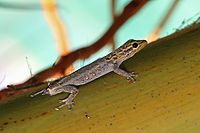
Photo from wikipedia
Lizard tail autotomy is an antipredator strategy consisting of sturdy attachment at regular times but quick detachment during need. We propose a biomimetic fracture model of lizard tail autotomy using… Click to show full abstract
Lizard tail autotomy is an antipredator strategy consisting of sturdy attachment at regular times but quick detachment during need. We propose a biomimetic fracture model of lizard tail autotomy using multiscale hierarchical structures. The structures consist of uniformly distributed micropillars with nanoporous tops, which recapitulate the high-density mushroom-shaped microstructures found on the lizard tail’s muscle fracture plane. The biomimetic experiments showed adhesion enhancement when combining nanoporous interfacial surfaces with flexible micropillars in tensile and peel modes. The fracture modeling identified micro- and nanostructure-based toughening mechanisms as the critical factor. Under wet conditions, capillarity-assisted energy dissipation pertaining to liquid-filled microgaps and nanopores further increased the adhesion performance. This research presents insights on lizard tail autotomy and provides new biomimetic ideas to solve adhesion problems. Description Engineered for a quick escape When under attack, lizards will shed their tails as a way of escaping the predator while leaving behind a wiggling decoy to distract the enemy. The tail needs to be firmly attached most of the time, but it must also have a quick-release mechanism that won’t engage during normal activities. Baban et al. devised a multiscale hierarchical model for the tail attachment (see the Perspective by Ghatak). Microscopy data of the broken surfaces of the tail showed that the fracture plane consists of mushroom-shaped pillars with nanopores at their tops. These pillars allow for enhanced adhesion of the tail in tension and peeling modes but enable fracture during oscillatory bending. The authors confirmed their hypothesis using polymer models and modeling. —MSL A biomimetic fracture model of lizard tail autotomy reveals a sophisticated interfacial attachment strategy.
Journal Title: Science
Year Published: 2022
Link to full text (if available)
Share on Social Media: Sign Up to like & get
recommendations!